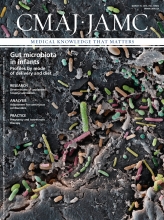Intraosseous vascular access allows clinicians to infuse fluids or blood products, deliver resuscitation medications and obtain blood samples
Intraosseous vascular access is a technique in which the bone marrow cavity is used as a noncollapsible vascular entry point (Figure 1). It is considered to be the standard alternative to peripheral intravenous access and is endorsed in major resuscitation guidelines,1 including Pediatric Advanced Life Support, Advanced Cardiac Life Support and Advanced Trauma Life Support. It should be considered early in the resuscitation of critically ill adult or pediatric patients if rapid and timely peripheral intravenous cannot be established or has failed.
An intraosseus needle within the bone marrow cavity.
Image courtesy of Vidacare Corporation
An intraosseous needle can be inserted into the proximal tibia, distal tibia, proximal humerus, iliac crest and sternum
Using the proximal tibial site (most common site; Appendix 1, available at www.cmaj.ca/lookup/suppl/doi:10.1503/cmaj.120971/-/DC1), an observational study achieved flow rates of 165 mL/min (1 L in just over 6 min).2 These rates are more easily accomplished with a 10 mL flush of saline before infusion and the use of a pressure bag.
Pain related to intraosseous needle insertion and infusion in awake patients is low
In an observational study involving healthy adult volunteers, mean insertion and removal pain scores measured on a 10-point visual analogue scale were 3.9 (standard deviation [SD] 1.5) and 2.2 (SD 2.9), respectively.3 Treatment with 1 mL of 2% lidocaine before infusion produced a mean infusion pain score of 2.0 (SD 1.2) with 300 mm Hg of infusion pressure.
The intraosseous route can be used to provide medications during cardiopulmonary and other types of resuscitation
A review of common resuscitation medications given during cardiac arrest showed the intraosseous route to be efficacious and safe for medications including, but not limited to, adenosine, calcium chloride, dextrose, epinephrine, lidocaine and sodium bicarbonate.4
Although an intraosseous line is a safe method for gaining vascular access, there are contraindications to its use, and complications may occur
Contraindications to use include long bone fracture, vascular injury of the extremity, cellulitis and a previous orthopedic procedure (including a previous intraosseous line within 24 hr) at the planned site of insertion. Complications include infection (e.g, cellulitis, abscess, osteomyelitis) and fracture. Extravasation, the most common complication, can lead to compartment syndrome if undetected.5 To decrease the rate of complications, one should ensure proper aseptic technique with insertion, check for extravasation after insertion and remove the intraosseous needle once further peripheral or central access has been secured, ideally within 24 hours.1
CMAJ invites submissions to “Five things to know about …” Submit manuscripts online at http://mc.manuscriptcentral.com/cmaj
Footnotes
-
Competing interests: None declared.
-
This article has been peer reviewed












